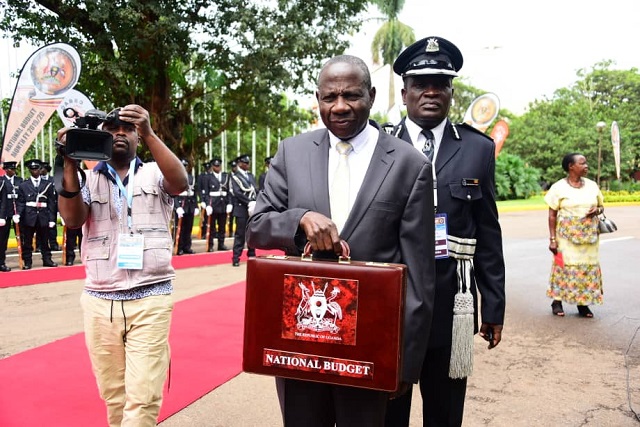
Kampala, Uganda | THE INDEPENDENT | Government plans to collect 20.4 trillion Shillings with over 18.87 trillion coming from tax revenues in the coming financial year.
Only 1.5 trillion Shillings is expected from Non-Tax Revenue (NTR) sources, so as to finance the 10.48 trillion Shilling 2019/2020 financial year budget.
Uganda Revenue Authority (URA) is set to collect all Government revenues including Appropriation in Aid (AIA) which has been currently collected by different government entities.
The targeted revenue including AI translates into a revenue effort of 16.8 percent of Gross Domestic Product (GDP) and 16 percent in the National Development Plan II (NDPII) for financial year 2019/2020.
The budget will also be financed by resources from the Petroleum Fund amounting 445.8 billion, Domestic Financing 2.82 trillion, external financing consists of Project Support of 9.4 trillion, general budget support 675.2 billion.
Domestic re-financing amounts to 6.452 billion and Appropriation in Aid is 201.1 billion Shillings.
Finance Minister Matia Kasaija on Thursday presented the budget at Kampala Serena Hotel themed ‘Industrialization for Job Creation and Shared Prosperity’.
According to Kasaija, government has put in place several tax measures to help URA achieve the required revenue.
The presented budget scraps and exempts a number of taxes but still maintains some taxes and imposes new ones so as to raise revenue.
Some of the taxes are the 200 Shillings per litre maintained on non-alcoholic drinks, 2 percent per month interest penalty on late payment of all excise duty, adjustment of the Stamp Duty rate on bank guarantees, insurance performance bonds, and indemnity bonds to 100,000 Shillings and others.
Kasaija’s budget re-introduces withholding VAT of 6 percent of the taxable value and also provides for exemption of compliant taxpayers. This tax which was previously 18 percent was suspended last year.
Government will also require registration of manufacturers, importers and providers of excisable goods and services. This will also reinforce other tax reforms like digital tax stamps.
Kasaija said that Withholding tax on long term bonds has been reduced from 20 percent to 10 percent to encourage investment in long term Government securities but at the same time reduce financing costs to Government.
Meanwhile, Value Added Tax (VAT) on different items has been exempted. These include imported mathematical and geometry sets used in schools. Also exempted is the supply of imported crayons, rulers, technical drawings sets, laboratory chemicals and others in order to reduce their cost.
Aircraft insurance services, rice mills, agricultural sprayers, woodworking machines, welding machines and sewing machines have also been exempted from paying VAT.
Income derived from leasing or letting facilities in industrial parks has been exempted from income tax for 10 years from the date of commencement of construction.
Supply of drugs and medicines manufactured in Uganda and sundries which are necessary in the medical value chain have been zero-rated to make health services more affordable. This means that suppliers of drugs and medicines will be able to recover input VAT incurred.
Kasaija further noted that to promote investment and industrialization, import tariffs on products which are locally manufactured have been increased.
The Minister expounded on tax administration reforms noting that this was necessary for sustainable revenue collection. He said that Uganda Revenue Authority will strengthen its capacity to effectively collect taxes involving recruitment of additional staff, skills development in specialized areas such as audit, investigations and risk analysis and the modernization and expansion of ICT capability.
Out of the 40.48 trillion budget, 27.957 trillion Shillings is Recurrent (10.5 trillion) and Development (17.3 trillion) expenditure while 12.53 trillion is Statutory expenditure charged directly on the Consolidated Fund.
The largest proportion of the budget for the coming financial year goes to Works and Transport sector taking 6.4 trillion Shillings up from 4.7 trillion Shillings. It is followed by the Security Sector with 3.6 trillion Shillings up from 2.06 trillion and the Education Sector allocated 3.2 trillion up from 2.7 trillion.
The other sector allocations are Energy and Mineral Development Sector at 2.9 trillion, Health 2.5 trillion, Accountability Sector 1.9 trillion, Justice Law and Order Sector at 1.6 trillion, Local Government Sector 1.2 trillion, Water and Environment 1.04 trillion, Agriculture 1.01 trillion an others.
Some of the least funded sectors are Tourism with 157 billion, ICT 123 billion, Trade and Industry with 171 billion, Science and Technology 159 billion, Lands and Housing 193 billion, Social Development 218 billion and others.
The 2019/2020 Budget themed ‘Industrialization for Job Creation and Shared Prosperity’ is structured along six major thematic areas including harnessing key growth Sectors of Agriculture & Agro-Industry, Tourism, OiI, Gas, and Minerals; Enhancing Private Sector Growth and Development; Promoting Human Capital Development; Strengthening Public Sector Investments and others.
The others are Improving Governance and Sustaining Security; developing a financing framework anchored on both an effective Domestic Revenue Mobilization Strategy and a responsive Debt Management Strategy.
According to the budget, Debt repayment takes 10.6 trillion in the coming 2019/2020 financial year national budget. This amount towards debt has been increasing over the years with 9.9 trillion Shillings earmarked in the current financial year 2018/2019 budget, 7.7 trillion earmarked in 2016/2017 financial year while 6.5 trillion was allocated in 2015/2016 financial year.
******
URN
 The Independent Uganda: You get the Truth we Pay the Price
The Independent Uganda: You get the Truth we Pay the Price



